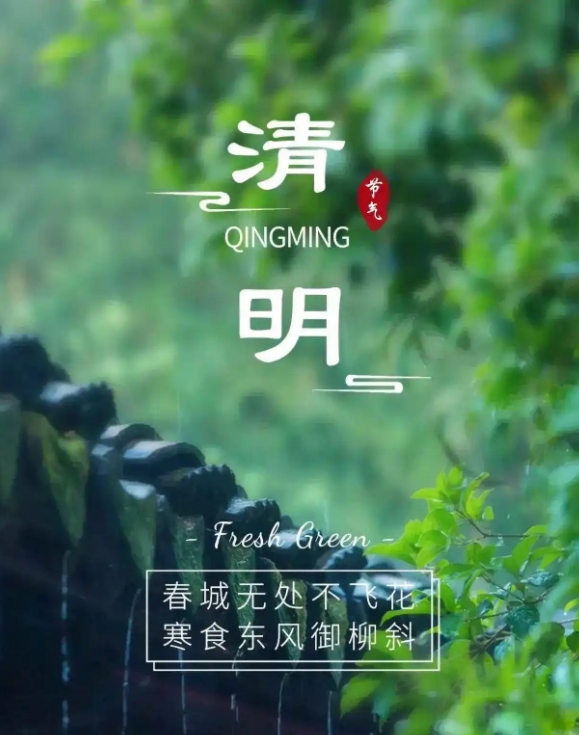清明 Qingming
发布时间:2024-04-04 浏览次数:
历史起源
谈到清明节,有点历史知识的人,都会联想到历史人物介子椎。据历史记载,在两千多年以前的春秋时代,晋国公子重耳逃亡在外,生活艰苦,跟随他的介子椎不惜从自己的腿上割下一块肉让他充饥。后来,重耳回到晋国,作了国君(即晋文公,春秋五霸之一),大事封赏所有跟随他流亡在外的随从,惟独介子椎拒绝接受封赏,他带了母亲隐居绵山。
Qing Ming is popularly associated with Jie Zi Zhui, who lived in Shanxi province in 600 B.C. Legend has it that Jie saved his starving lord's life by serving a piece of his own leg. When the lord succeeded in becoming the ruler of a small principality, he invited his faithful follower to join him. However, Jie declined his invitation, preferring to lead a hermit's life with his mother in the mountains.
晋文公无计可施,只好放火烧山,他想,介子椎孝顺母亲,一定会带着老母出来。谁知这场大火却把介子椎母子烧死了。为了纪念介子椎,晋文公下令每年的这一天,禁止生火,家家户户只能吃生冷的食物,这就是寒食节的来源。
Believing that he could force Jie out by burning the mountain, the lord ordered his men to set the forest on fire. To his consternation, Jie chose to remain where he was and was burnt to death. To commemorate Jie, the lord ordered all fires in every home to be put out on the anniversary of Jie's death. Thus began the "cold food feast", a day when no food could be cooked since no fire could be lit.
寒食节是在清明节的前一天,古人常把寒食节的活动延续到清明,久而久之,清明取代了寒食节。拜介子椎的习俗也变成了清明扫墓的习俗了。无论以何种形式纪念,为了使纪念祖先的仪式更有意义,我们应该让年轻一代的家庭成员了解先人过去的奋斗历史,当然,还要学习介子椎宁死不屈的气节。
The "cold food" festival occurs on the eve of Qing Ming and is often considered as part of the Qing Ming festival. As time passes, the Qing Ming festival replaced the "cold food" festival. Whatever practice is observed,the basic observation of Qing Ming is to remember one's elders by making a special effort to visit their graves, ashes or ancestral tablets. To make the visit even more meaningful, some time should be spent to remind the younger members of the family of the lives and contributions of their ancestors, and the story of Jie Zi Zhui who choose death over capitulation.
节日习俗
祭祀扫墓
清明之祭主要祭祀祖先,表达祭祀者的孝道和对先人的思念之情,是礼敬祖先、慎终追远的一种文化传统。
The Qingming Festival mainly worships the ancestors, expresses the filial piety of the sacrificers and the feelings of missing the ancestors, and is a cultural tradition of respecting the ancestors and chasing the distance carefully.
扫墓祭祖习俗在先秦以前就有了,由于古时南北风俗各异,有些地方扫墓不一定是在清明之际。唐代以前北方一些地区扫墓主要在寒食节与寒衣节,到唐宋后清明扫墓才开始在全国范围盛行,唐代是各地墓祭风俗融合时期,沿袭清明墓祭风俗,并扩大到全国各地。
The custom of sweeping tombs and worshiping ancestors existed before the pre-Qin period, and due to the different customs in the north and south in ancient times, tomb sweeping in some places was not necessarily on the occasion of the Qingming Festival. Before the Tang Dynasty, tomb sweeping in some northern areas was mainly in the cold food festival and winter clothes festival, and after the Tang and Song dynasties, tomb sweeping began to prevail throughout the country, and the Tang Dynasty was a period of integration of tomb sacrifice customs in various places, following the tomb sacrifice customs of Qingming Dynasty, and expanding to all parts of the country.
清明踏青
清明期间是春意盎然的时节,万物萌动之时,迎春郊游于野外早就已成为风俗。踏青又叫春游,古时叫探春、寻春等。踏青这种节令性的民俗活动,在我国有着悠久的历史,其源泉是远古农耕祭祀的迎春习俗。清明时节,春回大地,自然界到处呈现一派生机勃勃的景象,正是郊游的大好时光。人们乃因利趁便,扫墓之余亦一家老少在山乡野间游乐一番。
During the Qingming period, it is the season of spring, when all things sprout, it has long become a custom to welcome spring outings in the wild. It is also called spring outing, and in ancient times, it was called spring exploration, spring hunting, etc. This kind of seasonal folk activity has a long history in our country, and its source is the ancient spring custom of agricultural sacrifice. In the Qingming season, spring returns to the earth, and the natural world presents a vibrant scene everywhere, which is a good time for outings. People take advantage of the convenience of the people, and in addition to sweeping the graves, the family also has fun in the mountains and countryside.
特色美食
青团 | Green rice ball
江南地区的人们经常在清明节食用这种由糯米制成的绿色团子。由于糯米中混合雀麦草汁,所以团子呈绿色。
People in the Jiangnan region often eat this kind of greencolored balls made from glutinous rice on Tomb Sweeping Day. The green color isfrom the juice of brome grass that is added in the rice.
馓子 | San zi
在中国,无论是北方还是南方,都有清明食用馓子(通过油炸面粉制成)的传统。差别在于北方馓子以麦面为主料,体积较大;而南方馓子则以米面为主料,更为精细。
In both Northern and Southern China, it is a tradition to eatsan zi, or fried dough twist, on Tomb Sweeping Day. The differences between sanzi made by Northern and Southern people lie in sizes and materials. The formerone is larger, often made from wheat and the latter is finer and made fromrice.


